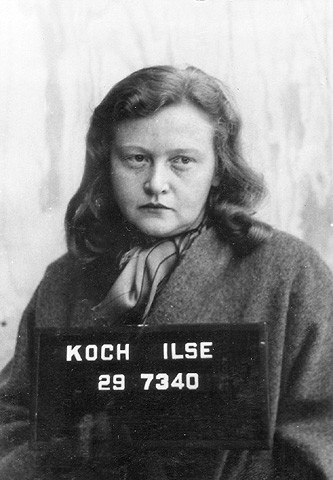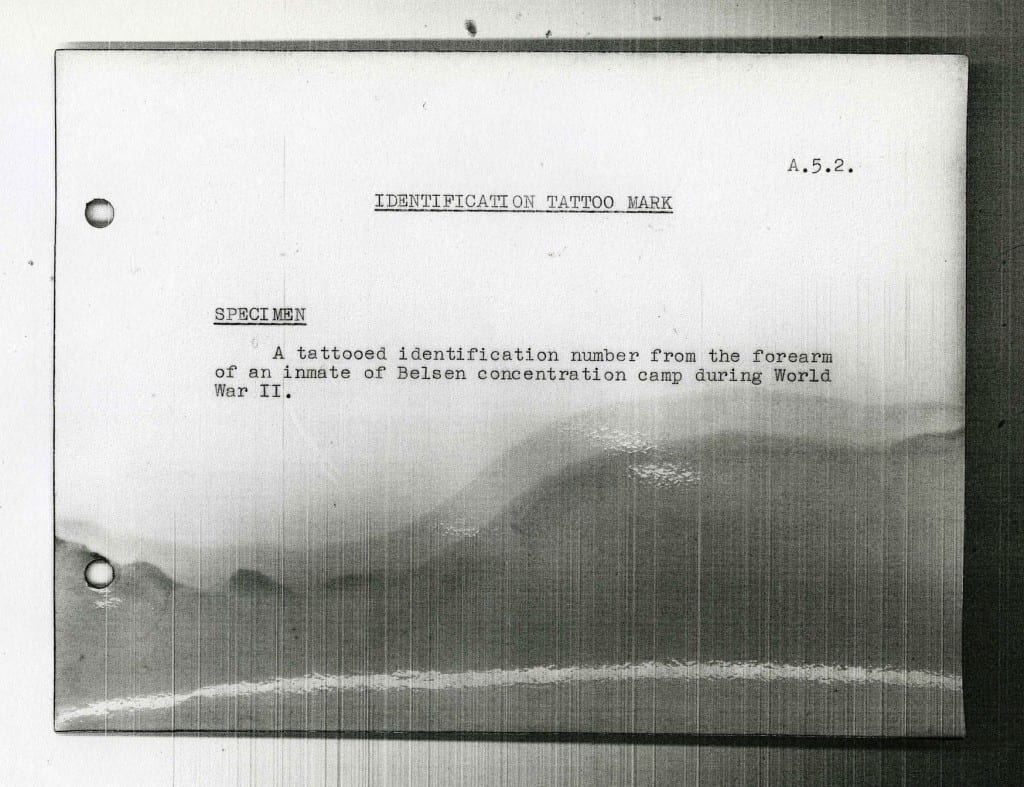A Dark Chapter in Tattoo History: Nazi Prisoner Tattoos
By Gemma Angel, on 28 January 2013
 by Gemma Angel
by Gemma Angel
Edit note: This post was amended on 25 August 2023 in order to remove an image of the tattoo, remove broken links, provide further detail on the UCL Pathology Collections and update the pejorative use of ‘inmates’ to describe interned people.
Over the course of the past 3 years working on the history of preserved tattooed human skin, I have frequently met with difficult questions: Material and conservation concerns pose the question how were they preserved? Historical and anthropological approaches lead me to ask why were they collected? – which of course raises the inevitable consideration of who were these people? Who did the tattoos belong to in life, and who collected them postmortem? This has proven to be the most thorny question of all – identifying both the tattooees and the collectors of tattooed skin is challenging in itself – but quite often it is the relationship between these two groups that raises the most controversial issues.
Frequently, a relationship of power and domination emerges, in which one group has the authority to study, scrutinize, classify – and ultimately, to dissect and preserve – the bodies of others under their institutional control. This is certainly the case for tattoos collected during the late 19th century by physicians and criminologists, who studied the tattoos of criminals and military personnel in prisons, barracks and hospitals. The criminals, soldiers and common men in these institutions very likely did not give consent for their tattoos to be excised and preserved after death; a practice that was rarely questioned during the late 19th century.

Ilse Koch was the wife of Karl Otto Koch,
Kommandant of the Buchenwald and Madjanek
concentration camps. She was convicted of war
crimes in 1947 and sentenced to life imprisonment.
The collecting of tattooed human skin – both for research purposes and as a kind of fetishized collector’s item – tailed off dramatically after the end of the second World War in the wake of revelations of Nazi concentration camp atrocities. Reports emerged from Buchenwald of the manufacture of everyday items such as gloves, knife sheaths, book-bindings and lampshades from the skins of murdered inmates.[1] In particular, stories of the collection of tattooed human skin, removed from the bodies of inmates at the behest of Ilse Koch, the wife of Kommandant Karl Otto Koch, caused a scandal in the Allied press. Although photographs documenting some of these objects were taken when the camps were liberated, no other material evidence of them was recovered to be entered into Koch’s trial at Dachau in 1947, or later at her second trial at Augsburg in 1950. Without material proof, Koch could not be convicted of the charges relating to the human skin objects.
The Nazis did not just collect the tattoos of prisoners as grotesque trophies of war, however – they also used tattooing as a weapon of dehumanization and control. From May 1940, prisoner numbers were introduced for all concentration camp prisoners deemed capable of work at the Auschwitz concentration camp complex – those sent directly to the gas chambers were not registered and did not receive numbers. These numbers were initially sewn onto prisoner uniforms. However, as the daily mortality rate increased and clothes were removed, this soon proved impractical as a way of identifying the dead. Tattooing of prisoner numbers was thus introduced at Auschwitz in the autumn of 1941. Tattoos were applied to either the inner or outer side of the left forearm on registration at the camp. More than 400,000 inmates were forcibly tattooed in this way at Auschwitz.
The SS introduced number sequences beginning with ‘A’ in mid-May 1944 – 20,000 men and 30,000 women were assigned numbers in this series. One of these women was Holocaust survivor Henia Bryer, who was liberated from Bergen-Belsen concentration camp in 1945. Henia still bears the number ‘A26188’ inscribed on her inner arm. She described her reasons for keeping her prisoner tattoo in a recent BBC programme:
I was offered by various surgeons to remove it, and they were very glad to do it, but I wanted to keep it on. So that when people say that it didn’t exist – these days, that the Holocaust didn’t exist, it’s a figment of your imagination – I wanted to show them. And many people don’t even know what this number means, still today. I wanted to keep it as a witness … as a sign that it really happened.
Tattoos carry with them a powerful capacity to evoke memory, and this quality is often a motivating factor for many people who choose to become tattooed with marks commemorating important life events or rites of passage. For those, like Henia, who have been forcibly tattooed, the mark may come to stand as testament to a personal and collective history of suffering and survival. For other Holocaust survivors, these marks became unwelcome reminders of trauma, and were removed by surgeons after the war. Some of these tattoos were retained in pathology collections, perhaps for reasons similar to those described by Henia above – ‘to stand witness’ to Nazi war crimes that should never be excised from the historical memory.
Whilst working with the UCL Pathology Collections, I came across such a tattoo: a small skin specimen in a perspex vitrine, catalogued as A.5.2 (pictured above). The original documentation associated with this object is the brief catalogue entry: “A tattooed identification number from the forearm of an inmate of Belsen concentration camp during World War II.”* No other information is known about this individual – since only people interned at Auschwitz were tattooed, it is very likely that this person, like Henia, endured the “death marches” from Auschwitz to Bergen-Belsen, where they were later liberated. Many Nazi records were destroyed at the end of the war, and the many thousands of files that do remain are scattered across Europe – even today, it is difficult to trace the identities of interned people based on their tattooed prisoner numbers.
Nor is it known exactly where this specimen was acquired, or who preserved it. Over the past 25 years, UCL Pathology Collections have absorbed a number of collections originating from other London medical institutions as a result of the creation of the Bloomsbury Health Authority in 1982 and subsequent UCLH NHS Trust established in 1994. A large number of the pathology specimens received by UCL arrived in a state of neglect, requiring intensive conservation and re-cataloguing – a task made all the more difficult for the lack of associated documentation. Specimens such as A.5.2 may make us uneasy, particularly when they are unprovenanced and inherited. Their histories are lost and fraught with ethical entanglements – but they cannot simply be discarded, and perhaps should not be hidden away. Henia reminds us of the need to remember past trauma, and of the role that material culture can play in this process. Nazi prisoner tattoos are a powerful reminder of the lived experience of war and genocide. As objects, their presence in pathology collections is undoubtedly troubling; yet they remain as an important testament to the horrors of the Holocaust – they are fragments of lives that should never be forgotten.
References:
[1] Flint Whitlock: The Beasts of Buchenwald, (2011) Cable Publishing, p.81. See also, Alexandra Przyrembel: ‘Transfixed by an Image: Ilse Koch, the ‘Komandeuse of Buchenwald’, in German History, Vol. 19 No. 3, (2001).
*The current catalogue entry for this specimen reflects recent research and has been updated to amend the pejorative term ‘inmate’. A.5.2
[analytics-counter]
 Close
Close


